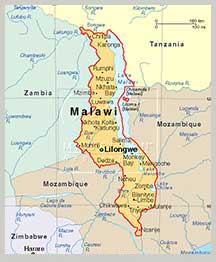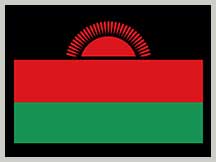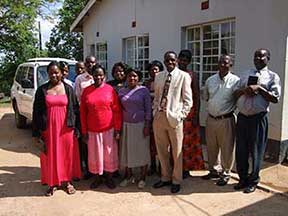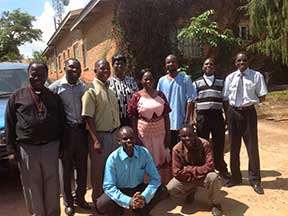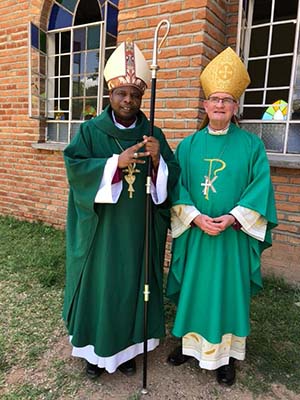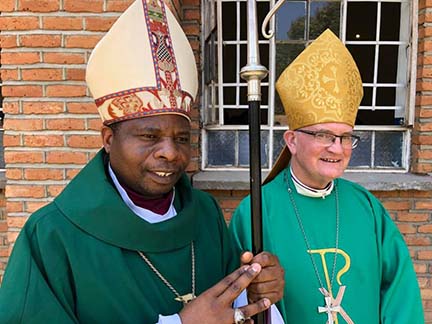This is the day that the Lord has made and we will rejoice and be glad in it. We give thanks to God that our first Bishop of the Diocese has made it to a Golden Jubilee in his ministry.
The Rt. Reverend Jackson Cunningham Biggers was born in Corinth, Mississippi on May 16, 1937. His father was a farmer and owned a hardware store. He went to public schools in Corinth, and then attended Georgetown University in Washington, DC and received a Bachelor of Liberal Arts degree from the University of Mississippi in 1960.
He then went to the University of the South in Sewanee, Tennessee where he attended St. Luke's Seminary where he received a Masters of Sacred Theology degree in 1963. In 1998 he received an honorary Doctor of Sacred Theology degree from the University of the South. He was ordained Deacon by the Bishop of Mississippi in 1963 working at St. James' parish in Jackson Mississippi and then he was ordained priest there in 1964.
He came to Malawi because he had heard a sermon preached by Bishop Stephen Neil from India while he was in Sewanee. Bishop Neil said that priests and church workers were needed throughout the British Empire prior to the independence of so many British colonies. Later, Bishop Arden spoke to the students at the seminary and he decided then that he would, with God's help, love to go to Malawi.
Bishop Biggers arrived in his new destination in 1964 and was rector of St. Peter's, Lilongwe for two years. St. Peter's was then the only Anglican church in Lilongwe, under the Archdeacon of Ntchisi.
Through his leadership the rectory was built along with a guest house which is still offering accommodation to this day.
In 1964 Bishop Biggers was sent to Nkhotakota to be Chaplain to Bishop Mtekateka who was the Suffrigan Bishop of Malawi. He managed to do this work while serving as priest in charge of Kasamba parish.
Bishop Josiah and his wife Alice were very close to Bishop Biggers and so many times he recalls some of the good stories they shared with each other. They called him their first born son. Bishop Biggers considers himself blessed to have worked with Bishop Josiah and to have know all the wonderful and interesting people at Nkhotakota during those years.
In 1972 he was made the first Archdeacon of Lilongwe. During that time, the new Capital was built. This prompted him to build a second Anglican Church for Lilongwe, St. Mary's at Biwi.
Sadly, he was exiled from Malawi by the government in 1974. He had been misquoted by someone involving the mentioning the name of Chipembere who at that time was exiled in the United States. In addition to this, he had also called a meeting of Church leaders on how they might stop the persecution of the Jehovah Witnesses who at that time were being beaten, killed, and forceably thrown out of Malawi. These were considered anti government crimes. Returning to the USA, the Presiding Bishop (Archbishop) of the American Episcopal Church temporarily made him his chaplain. He was then called to be rector of the Anglican Church on Long Island in the Bahamas.
Bishop Biggers was there for a very short time because the rector of a church at his home in Mississippi retired and he was asked to return home and become the rector of the Church of the Redeemer in Biloxi, Ms.
The Bishop was at the Church of Redeemer, Biloxi from 1977 until 1994 when he was called to establish a new diocese in Malawi and to be the first bishop.
When asked if he would allow his name to be put forward, he responded that, “I felt it best for a Malawian to be made the bishop and if wanted, then he could have a European diocesan administrator.” However the Parishioners, particularly those from St. Peter’s, Likoma Island who knew him very well did not accept that. Among them were the Late Mr. Frank Chithila, Mrs. Beatrice Gema Polela, and Canon Mtekateka. They were instrumental in the elective process just to mention a few.
He was elected Bishop and he had to come back to the same place from whence he had been exiled so many years before. Perhaps like the call of Israel from Egypt; or much more like the call of our Lord when the angel announced to Joseph to come back for those who wanted to kill the child were dead. Indeed at that time the government of Malawi had just change from a one party State with Kamuzu as the life President to a Democratic State.
Bishop Biggers indeed was called to the work of a pioneer Bishop in the establishment of a diocese. He began his work as a diocesan bishop without necessary recourses. The houses on Likoma Island were in a dilapidated state. There was no office in Mzuzu which he could use for the Diocesan office. There was nothing like the bishop’s house and all the things we see today.
After setting up the foundation of the Diocese, when people needed him most, he sadly resigned a year before the mandated retirement age because of having cancer. The cancer was discovered in 1997 and today he is not troubled by it.
Bishop Biggers left Malawi in 2000 but continues to live here most of the time. It is because of his love for the people and the nation that he has a permanent residency in the hills of Zomba at Kuchawe area.
In the United States, he keeps an apartment in Pensacola Florida in a retirement community known as Azalea Trace.
Bishop Biggers has been a Christian since his Baptism as an infant. He has always been aware of Christ's presence with him.
When he was young, his brother and he had a black American nanny. She always called bishop Biggers the little priest and she called his brother the little Judge. Surprisingly they were not even two or three years old when she bestowed these titles on them. Years later her intuition came true and today Bishop Biggers is indeed a priest and not only that, but also a Bishop; and of course he is our Bishop Emeritus. Also, his brother is indeed a judge, just as she said. It for this reason that we have come together today to give thanks to God for the calling of our Bishop Emeritus into Holy Orders. He is cerebrating fifty years of ministry this coming Feast of St. Alphege on April 19. However for the same reason we gather on this day today to praise the Lord that Bishop Biggers shared his ministry with us in Malawi. Glory be to God.
We give thanks to God because of the life and work of Bishop Biggers in the formation and the foundation of this Diocese. When we look back to the time the Diocese was formed we can say that our elders did not make any mistake to invite him to be our first bishop of this Diocese.
When this Diocese began there was not an office in Mzuzu to host the Diocese. There was not any house of our own to host the bishop as his house. All the mission houses on Likoma Island were in a dilapidated state. This included the Cathedral itself. Everything was in ruins mate yake bwinja lenileni.
We can deduce his achievements into the following subtopics. Healthy Delivery Services, education both Primary and Secondary School, Relief aid to the most need people, welfare of the clergy and their training, above all he is also known as Bishop Walisungu.
M’dzina la Atate ndi la Mwana ndi la Mzimu Woyera. Amen.
Contributed by The Rt. Rev. Fanuel Magangani
Bishop Boyle shepherded the Diocese of Northern Malawi from 2001 - 2009. He moved back to England to serve as Assistant Bishop of Leicester in the Church of England.
Welcome back home Bishop Boyle. We rejoice in the Lord for your coming. 10-14-2018.
